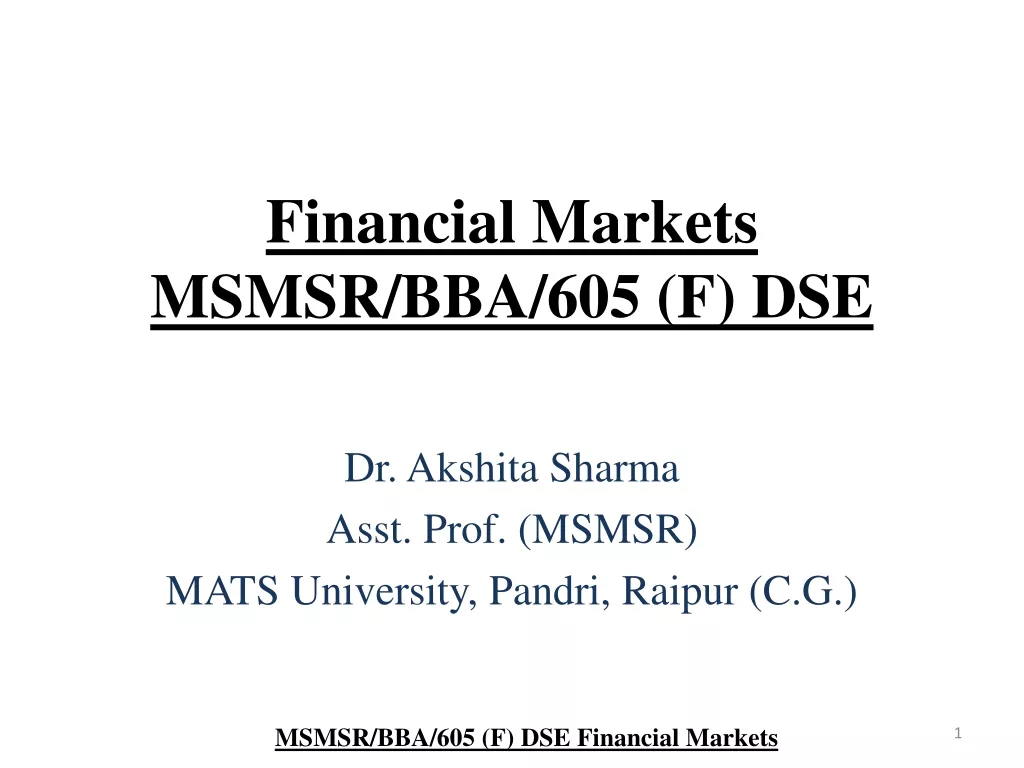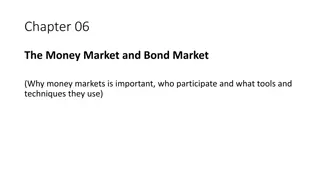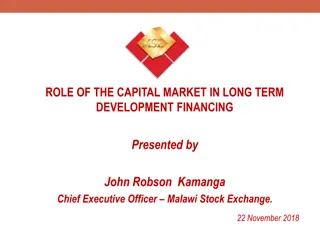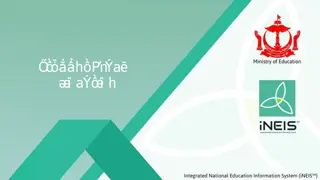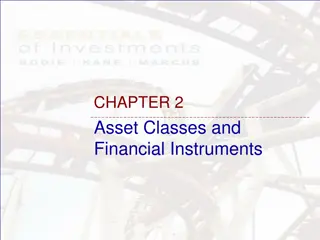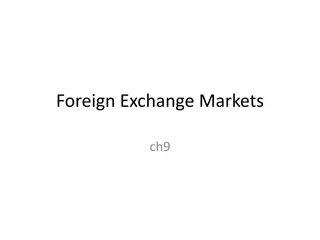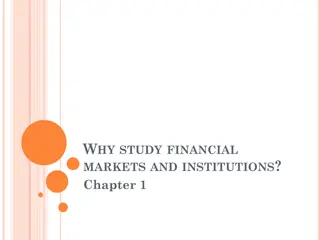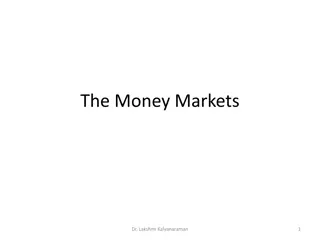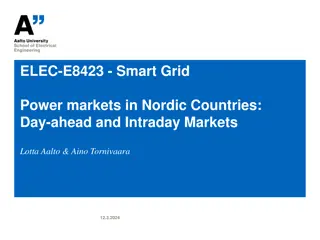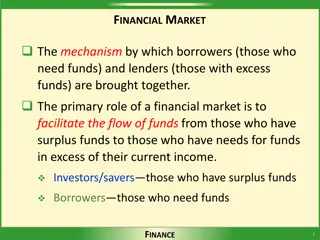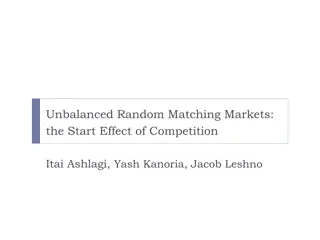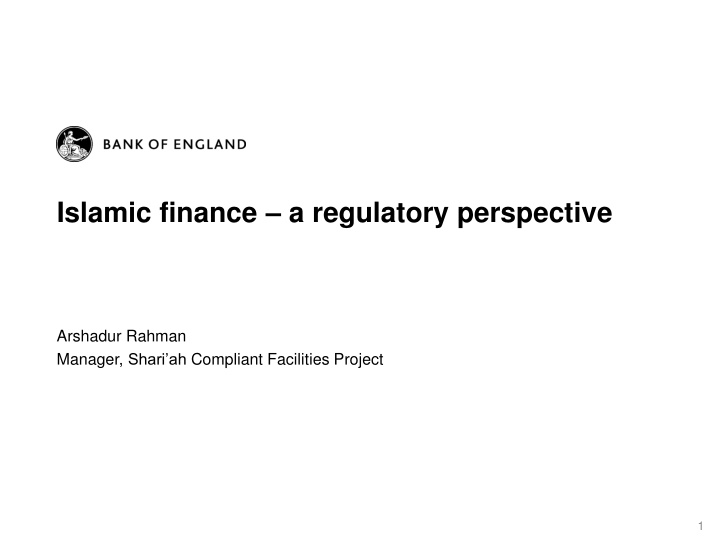
Islamic Finance: Origins, Principles, and Market Growth
Explore the origins and key principles of Islamic finance, which is rooted in Shariah law and emphasizes ethical practices. Learn about recent developments in the market and the global growth of Islamic banking assets.
Uploaded on | 2 Views
Download Presentation

Please find below an Image/Link to download the presentation.
The content on the website is provided AS IS for your information and personal use only. It may not be sold, licensed, or shared on other websites without obtaining consent from the author. If you encounter any issues during the download, it is possible that the publisher has removed the file from their server.
You are allowed to download the files provided on this website for personal or commercial use, subject to the condition that they are used lawfully. All files are the property of their respective owners.
The content on the website is provided AS IS for your information and personal use only. It may not be sold, licensed, or shared on other websites without obtaining consent from the author.
E N D
Presentation Transcript
Islamic finance a regulatory perspective Arshadur Rahman Manager, Shari ah Compliant Facilities Project 1
Presentation structure 1. Definitions, origins and key principles 2. The market and recent developments 3. Regulatory and policy implications 4. The Bank of England s Shari ah compliant facilities (SCF) project 2
What is Islamic finance? Shari ah refers to the high level principles of Islamic law Islamic finance is a broad term covering products and services deemed consistent with Islamic commercial jurisprudence ( fiqh ) Commonly framed in terms of prohibitions against what are considered to be socially detrimental activities/industries (e.g. alcohol, gambling, tobacco, etc), and especially charging interest But also entails a greater emphasis on risk/reward sharing, transparency, sustainability, and social justice Overlap with the broader ethical/sustainable finance movement 4
Origins The well known prohibition on interest can be found in various traditions through history e.g. Hinduism, Buddhism, ancient Greece, Judaism, Christianity and Islam Early Islamic finance was based on nominate commercial contracts used by the Muslim community from AD/CE c.620 onwards In the modern context, Islamic finance motivated at least partly by desire for parallel/separate institutions and economic paradigms, by newly independent majority Muslim countries Mit Ghamr Savings Project in Egypt (1963) Islamic Development Bank (IDB) and Dubai Islamic Bank both established in 1975 5
Key principles Wealth creation must relate to broader social benefit Prohibitions on: Interest ( riba ) money is a medium of exchange, has no intrinsic value Excessive uncertainty ( gharar ) e.g. in contract terms, object of sale Hoarding capital should not sit idle. E.g. compulsory alms payments ( zakat ) are calculated on total wealth, not income Misrepresentation or lying Emphasis on: Risk and reward sharing partnership arrangements are preferable, rent-seeking should be avoided Transparency Fairness forced sales/sales under duress are forbidden 6
Islamic finance globally growth of the market Islamic banking assets growth over time and share by country Source: IFSB 2016 Stability Report Global Islamic finance assets currently estimated to be worth c.$2trn Mostly constituted by banking (c.$1.6trn) and capital markets (c.$0.4trn) Takaful sector much smaller: c.$22bn globally as of end 2014 The market is still young 8
Islamic finance globally key bodies The Islamic Development Bank (IDB) Multilateral Development Bank based in Jeddah Has already issued USD denominated sukuk (of which more later ) The Islamic Financial Services Board (IFSB) Issues standards on governance and risk management Collaborates with various bodies: BIS, IMF, IOSCO, IAIS The Accounting and Auditing Organisation for Islamic Financial Institutions (AAOIFI) Issues standards on accounting and Shari ah compliance Rules are binding in only a few jurisdictions (e.g. Bahrain, Sudan) The IMF(?) 9
Islamic finance in the UK recent history Various forms of Islamic finance activity since the 1970 s Shari ah compliant aviation leasing contracts from the 1970s Wholesale liquidity management from the 1980s Earliest forms of Islamic mortgages from the 1990s 2003 - Governor George confirmed no objection in principle to Islamic banking in the UK First standalone Islamic bank authorised in 2004, five more subsequently up to 2009 (though one is now an investment firm) Banking sector also includes 20+ windows 2014 - UK government issued its first sovereign sukuk 2015, the Bank commences Shari ah compliant facilities (SCF) project Also: commercial sukuk; asset management; insurance; advisory 10
Islamic finance in the UK financial products Shari ah compliant bank accounts structured in several ways: Current accounts can be structured as an interest free loan ( qard ) to the bank, repayable on demand Fixed term accounts can be structured as agency agreements ( wakalah ), the bank invests the funds in Shari ah compliant activity Home financing Structured as a sale/resale at mark-up ( murabaha ) of property by bank to customer, who pays down resale value through monthly increments A partnership arrangement ( musharaka ) - joint purchase by customer (initial deposit) and bank (outstanding value), with customer increasing ownership share via monthly instalments 11
Islamic finance in the UK financial products (cont.) Investment management Involves applying industry/financial screens to securities selection Shari ah compliant insurance( takaful ) Normally uses mutual-type structures to pool risk Limited activity in the UK currently, but growing Securitisation ( sukuk ) Commonly taken to represent a legal/beneficial interest in an asset or enterprise Economic/risk profile can vary depending on contractual details Most common structure for fixed income instruments is lease-based ( ijarah ) 12
Islamic finance in the UK the market currently Currently five standalone Islamic banks in the UK One retail (al Rayan Bank) Four largely wholesale (BLME, Gatehouse, QIB and ADIB) Combined balance sheet is c. 3.2bn Plus windows Combined value of sukuk issuances outstanding on the LSE: c.$38bn Insurance one underwriting agency; Lloyds becoming more active Various fund managers 13
Islamic finance in the UK Government policy Islamic finance first featured notably on the UK Government s objectives in 2007, and has cross-party support Tax treatment has been harmonised through successive pieces of legislation to ensure consistency with conventional instruments The current administration is promoting the UK as a centre for Islamic finance as part of its aim to increase inward investment/regeneration HMT/DMO s sovereign 2014 sukuk was very successful, oversubscribed 11.5 times a signalling device to encourage more corporate issuances Cross-Whitehall Islamic finance working group co-ordinates initiatives across govt jointly led by HMT and FCO 14
Islamic finance in the UK the sovereign sukuk 200m 5yr lease based sukuk secured on 3 central government buildings 15
The UK regulatory approach Our 2007 regulatory paper* outlined the key elements of our approach: No obstacles, but no special favours Level playing field We are a secular, not religious regulator No separate rule book for Shari ah compliant firms Consequently, we expect development of Islamic finance in the UK to be largely market led the authorities provide the framework for this to happen * http://www.fsa.gov.uk/pubs/other/islamic_finance.pdf 17
How does Shariah relate to the UK legal framework? Shari ah consists of high level principles, not rigid rules Therefore, interpretations of Shari ah can, and do, differ The UK applies a legal framework based on secular common law This means statutory authorities in the UK cannot opine on whether a product/activity is Shari ah compliant or not Precedent: Beximco vs. Shamil Bank (2004) It is up to the parties to a contract to satisfy themselves that the product is compliant with Shari ah principles, depending on their particular interpretation Adequate product disclosure is essential and relevant transparency requirements apply to all firms. 18
What is the regulatory position of Shariah scholars? Shari ah scholars are considered to act in an advisory capacity to Islamic banks Similar to a firm s external auditors or legal counsel They are therefore not generally required to be Approved Persons for regulated firms (i.e. authorised to engage in regulated activity) Caveat: if Shari ah scholars perform an executive/customer facing function for a regulated firm, then they do need to be Approved Persons 19
General considerations with Islamic finance Don t be overwhelmed by jargon! Focus on the economic and risk characteristics of the transaction/product/service Islamic financial products are not identical to conventional products care should be taken when assuming equivalence between e.g. bonds and sukuk Islamic finance is primarily a commercial enterprise, distinct from charitable activity As secular authorities, we do not opine on Shari ah compliance, but we can be mindful of market opinion 22
4. The Bank of Englands Shariah compliant facilities (SCF) project 23
Islamic banks - liquidity All banks in the UK must hold a buffer of liquid assets to comply with liquidity requirements Islamic banks find it challenging to source eligible assets which are both of sufficient quality and also Shari ah compliant. Total LAB requirement of 5 UK Islamic banks = c. 200m Total estimated sukuk stock globally = c.$390bn equiv. Of which, total HQLA estimate = c.$56bn equiv. But, most HQLA sukuk held to maturity, limited secondary market Rules offer some flexibility on eligible assets, subject to haircutting but not sufficient to address underlying scarcity Hence the Bank s project on Shari ah compliant facilities 24
The Shariah compliant facilities (SCF) project The Bank of England recognises the challenge of UK Islamic banks in meeting the liquidity requirements, given the current scarcity of eligible assets for the LAB We are therefore assessing the feasibility of establishing a Shari ah compliant central bank liquidity facility work on this formally commenced in H2 2015 The first stage was to survey and assess existing facilities in use by central banks around the world The Bank conducted a consultation green paper in 2016, receiving feedback from a range of stakeholders: Islamic banks, conventional finance firms, overseas central banks and regulators, scholars, academics 25
The Bank of Englands SCF assessment criteria We evaluated a number of SCF models against a set of agreed criteria: Transparency/simplicity Accessible specifically to the target population Fitness for purpose Consistency/fairness of pricing Acceptable degree of risk Compatibility with the Sterling Monetary Framework Proportionality of resource requirements Market readiness 26
SCF liquidity facilities around the world Deposit facilities: Liquidity support facilities: Collateralised commodity murabaha Wa ad (promise) a.k.a. sale and buy-back/Shari ah compliant repo Qard (interest-free loan) Wakalah (agency based fund model) Commodity murabaha (cost plus mark up) Wadiah (safe custody) Mudarabah (entrepreneurship) Other models: Open Market Operations (OMOs) Interbank clearing model Ju alah (task specific remuneration) 27
Shariah compliant facilities Deposit model 1: the fund based model 1. The central bank establishes a long-term fund constituted of sukuk, also using banknotes if necessary. 2. The Islamic bank makes a deposit with the central bank for a defined time period. The aggregate value of all Islamic banks deposits cannot exceed the value of the fund. 3. The rate of return on the deposit is based on the rate of return on the portfolio backing it. 4. and 5. On maturity, the return from the fund is paid over to the Islamic bank, and the principal amount is returned or rolled over. The wakalah fund remains in place for further/future deposits. 28
Shariah compliant facilities Deposit model 2: the commodity murabaha model 1. The Islamic bank purchases commodities from Broker A. 2. The Islamic bank sells the commodities to central bank at a mark-up, on a deferred payment basis. 3. The central bank appoints the Islamic bank as agent to sell the commodities back into market. 4. The Islamic bank sells the commodities to broker B on behalf of central bank for immediate payment. 5. The Islamic bank credits the proceeds to central bank. 6. On maturity, the central bank makes the deferred payment (including mark-up) to Islamic bank. 29
Next steps The Bank s 2017 white paper provides more technical detail of the proposed Shari ah compliant deposit facility Notwithstanding any material obstacles, implementation will follow (estimated to commence later in 2017) After a few years of operation, the facility will be evaluated against its objectives Subject to successful operation, the next stage will be to implement a Shari ah compliant liquidity support facility 31

